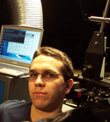|
|
This topic comprises 2 pages: 1 2
|
|
Author
|
Topic: booth regionalisms?
|
Scott Norwood
Film God

Posts: 8146
From: Boston, MA. USA (1774.21 miles northeast of Dallas)
Registered: Jun 99
|
 posted 10-25-2002 07:18 AM
posted 10-25-2002 07:18 AM





Gordon's mention of the popularity of Strong platters in his area reminded me of something that I've been meaning to ask for a while:What are some regional trends in booth design, and is there any reason for them? For example, I've noticed that changeover booths in New England commonly use a single pushbutton to activate picture and sound; footpedals are uncommon. By contrast, separate footpedals (for picture) and pushbuttons (for sound) seemed to be quite common when I was living in Virginia. As another example, I've been told that rewind benches on the west coast commonly have footpedal speed controls, while I've never seen this anywhere on the east coast. There's also the equipment factor--Strong platters being common in one area and Christies in others, etc. Has anyone else noticed anything like this?
| IP: Logged
|
|
|
|
John Hawkinson
Film God

Posts: 2273
From: Cambridge, MA, USA
Registered: Feb 2002
|
 posted 10-25-2002 09:27 AM
posted 10-25-2002 09:27 AM




Well, Scott, we have footpedal speed controls on all of our benches.I don't see how you could manage otherwise! One hand on the brake for the supply reel, one hand to check the film, how would you be able to
control the speed of the film without a third hand? As for single-pushbotton versus footpedal+pushbutton for changeover, umm, why would you ever want to design a system that let you changeover sound and picture independantly? That seems like asking for trouble! --jhawk
| IP: Logged
|
|
|
|
John Hawkinson
Film God

Posts: 2273
From: Cambridge, MA, USA
Registered: Feb 2002
|
 posted 10-25-2002 11:43 AM
posted 10-25-2002 11:43 AM




Daryl, how does that work? Do you have two 3-position switches, one on each projector, or is there a central switch somewhere?Our custom automation system has a single button that normally changes over sound and picture, but if it is pressed a second time, it closes the Zipper and turns off the sound. So if there's a changeover error (due to incorrect cues or operator error or whatever), pressing the changeover button a second time gets you happy nothingness, and then pressing it a third time changes back over. (Our system has auxilliary controls to override this, but they're rarely used...) --jhawk
| IP: Logged
|
|
|
|
John Pytlak
Film God

Posts: 9987
From: Rochester, NY 14650-1922
Registered: Jan 2000
|
 posted 10-25-2002 02:51 PM
posted 10-25-2002 02:51 PM





Booth layout and equipment choices tend to be uniform among particular chains. Big/loyal customers can sometimes negotiate favorable deals, discounts and terms. Consistency makes training easier, and requires less spare parts inventory. Mergers and acquistions complicate things (e.g., Regal/Edwards/UA and AMC/GCC).------------------
John P. Pytlak, Senior Technical Specialist
Worldwide Technical Services, Entertainment Imaging
Research Labs, Building 69, Room 7525A
Rochester, New York, 14650-1922 USA
Tel: +1 585 477 5325 Cell: +1 585 781 4036 Fax: +1 585 722 7243
e-mail: john.pytlak@kodak.com
Web site: here
| IP: Logged
|
|
|
|
Brad Miller
Administrator

Posts: 17775
From: Plano, TX (36.2 miles NW of Rockwall)
Registered: May 99
|
 posted 10-25-2002 04:31 PM
posted 10-25-2002 04:31 PM




In reference to the original question, Jon and John have really hit the nail on the head on point #1. Let's say you have a large chain. If you were to change your equipment with every location, your techs would have to be trained in on a lot more equipment and the option of running down the highway to the next theater in the chain to borrow a part would be out of the question. An excellent example of this is Cinemark. For YEARS they bought Simplex projectors, CFS consoles and SPECO platters. It would have been effortless for them to upgrade that CFS decision by purchasing Strong consoles with those Simplex projectors, but they never did (except in the locations nearby the Strong plant). They did have a year or two where they tinkered around with other options like Century projectors and Eprad platters, etc. In the end, they ended up putting in an all-Christie package, which they still use today. Maybe after a few years they will change to Kinoton, or Strong. Who knows, but whatever it is it will certainly be across the board.Point #2 The other thing I have noticed is that if a given dealer/service company is comfortable with a certain set of equipment, they will put it in every time and for those customers that are not convinced, they will do their damndest to convince them. This makes things easier on their techs because they generally only have to deal with one kind of setup and it gets them better profit margins as they give all of their business to one manufacturer of cinema equipment. Plus, certain brands of equipment (like Strong inparticular) in their pre-wire status makes installation a joke. The installation tech has almost nothing to do, so they can get in and out of there and still collect lots of money. So in this form, if there is a company X that covers most of Maine and they love Strong equipment, you will find Strong equipment all throughout Maine, whether it is the best equipment for the particular job or not. To the other John, you are still using a rewind with a brake? Get yourself a Kelmar RTV series rewind bench and do it right. Improper braking can damage film. I think we have more Johns on this forum than Scotts. 
| IP: Logged
|
|
Daryl C. W. O'Shea
Film God

Posts: 3977
From: Midland Ontario Canada (where Panavision & IMAX lenses come from)
Registered: Jun 2002
|
 posted 10-25-2002 06:10 PM
posted 10-25-2002 06:10 PM





John, I've used the three position 'paddle' in about three different ways.1. Tube amplifier, paddle at each projector is connected by a long steel rod that runs through the amp and through a single three position switch. The switch switches between (a) right proj solar cell, (b) shorted to mute amp, (c) left proj solar cell. This is probably my most favorite changeover setup (can't beat the tube amp). 2. Using a digital processor and the same switch setup as above with rod, etc. removed from old tube amp. This time the switch is wired (changeover latched, not pulsed) (a) right proj circuit closed, (b) mute circuit closed or unused depending on processor, (c) left proj circuit closed. 3. Using a digital processor or tube amp or anything else. Three positon switch (or two pos. with no muteing - either right or left) wired to a bunch of relays or transistors that either pulse or latch the processor or switch the solar cell outputs. With the third setup the switch is always being thrown in the opposite direction as last time, whereas the first 2 the switch is always up/right, middle/mute, down/left. If there's an error, you simply don't open the hand douser until you know you're going to have a picture to show. This way you don't have to switch over before you can close the c/o shutter and mute the sound. Also most c/o shutter buttons I've used around here are mounted in the pedastal, with the sound c/o to your right on the wall or amp. Motor switches seem to vary from pedestal mounted to wall mounted. I've only seen one c/o shutter foot switch at a drive-in (Elmvale, Ont. I think - which has nice comfy chairs to sit in and do the c/o). As for equipment, from the Cineplex Odeon multiplexes (in Canada) that I've seen, they like (liked) to use Strong A3 platters and Cinemeccanica V5's. For sound they usually have a mix of DTS, SDDS and Dolby. Having the same equipment throughout a chain might also indicate to head office a theatre that has more problems than they should, possibly due to inexperienced operators, etc., rather than 'I guess they got the bad brand of equipment'.
| IP: Logged
|
|
Steve Guttag
We forgot the crackers Gromit!!!

Posts: 12814
From: Annapolis, MD
Registered: Dec 1999
|
 posted 10-25-2002 07:28 PM
posted 10-25-2002 07:28 PM




Personally, I've always preferred separate picture and sound changeovers...that has the most flexibility. However, I find that I install mostly linked picture and sound changeovers. In fact, we have made custom boards to do just that with certain projectors that are not as friendly to the concept. Around here, footpedals were the preferred method of picture changeover by a long shot. Nowadays, I tend to use toggle switches (on)-off-(on) to allow switching to ether projector from either projector for those systems that use the traditional zipper/kelmar style of changeover. Steve ------------------
"Old projectionists never die, they just changeover!"
| IP: Logged
|
|
|
|
|
|
|
|
John Hawkinson
Film God

Posts: 2273
From: Cambridge, MA, USA
Registered: Feb 2002
|
 posted 10-25-2002 11:58 PM
posted 10-25-2002 11:58 PM




Ah, the Kelmar RTV series. Correct me if I'm wrong, but doesn't that place the reels and the film over the side of the bench? I suppose that's necessary with larger than 2000' reels, but it sure seems inconvenient.It looks like you have to drag the film at an odd angle to splice (or holder the splicer over air). And I can't imagine how you'd run the film through a frame counter. Or does the table extend out in the middle? --jhawk
| IP: Logged
|
|
|
|
All times are Central (GMT -6:00)
|
This topic comprises 2 pages: 1 2
|
Powered by Infopop Corporation
UBB.classicTM
6.3.1.2
The Film-Tech Forums are designed for various members related to the cinema industry to express their opinions, viewpoints and testimonials on various products, services and events based upon speculation, personal knowledge and factual information through use, therefore all views represented here allow no liability upon the publishers of this web site and the owners of said views assume no liability for any ill will resulting from these postings. The posts made here are for educational as well as entertainment purposes and as such anyone viewing this portion of the website must accept these views as statements of the author of that opinion
and agrees to release the authors from any and all liability.
|

 Home
Home
 Products
Products
 Store
Store
 Forum
Forum
 Warehouse
Warehouse
 Contact Us
Contact Us




 Printer-friendly view of this topic
Printer-friendly view of this topic

















